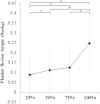Relation between abnormal synergy and gait in patients after stroke
- PMID: 25257123
- PMCID: PMC4189205
- DOI: 10.1186/1743-0003-11-141
Relation between abnormal synergy and gait in patients after stroke
Abstract
Background: The abnormal synergy seen in patients after stroke is considered to limit the ability of these patients. However, in the lower extremity, antigravity torque generation rather than precise movement is needed for functions such as sit-to-stand movement and gait. Therefore, the ability to generate torque may be important either as a primary movement or as an abnormal synergy. We attempted to quantify the torque generation in the lower limb, selectively and as an abnormal synergy, and its relation with gait.
Methods: Selectively generated plantar flexion torque in the ankle and plantar flexion torque secondarily generated accompanying maximal hip extension (i.e., torque generated with abnormal synergy) were measured in subjects after stroke and control subjects. In subjects after stroke, secondary torque generation while controlling hip extension torque as 25%, 50%, and 75% of the maximal hip extension was also measured. The relation of torque generation with the gait speed and timed-up-and go test (TUG) was also analyzed.
Results: In subjects after stroke, there was no difference between the amount of plantar flexion torque generated secondarily and the selectively generated torque, whereas the selective torque was significantly greater in control subjects. Pearson product-moment correlation coefficient analysis revealed that TUG speed is related to secondarily generated torque accompanying maximal hip extension but not with selectively generated torque.
Conclusion: Secondarily generated torque was found to be a factor that affects TUG speed, and the ability to generate torque even through abnormal synergy may help for gait ability in subjects after stroke.
Figures



References
Publication types
MeSH terms
LinkOut - more resources
Full Text Sources
Other Literature Sources
Medical

